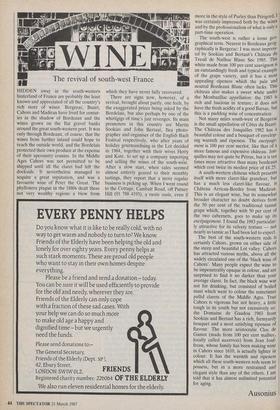The revival of south-west France
HIDDEN away in the south-western hinterland of France are probably the least known and appreciated of all the country's rich store of wines. Bergerac, Buzet, Cahors and Madiran have lived for centur- ies in the shadow of Bordeaux and the wines grown on the flat gravel banks around the great south-western port. It was only through Bordeaux, of course, that the wines from further inland could hope to reach the outside world, and the Bordelais protected their own produce at the expense of their upcountry cousins. In the Middle Ages Cahors was not permitted to be shipped until all the claret had left the dockside. It nevertheless managed to acquire a great reputation, and was a favourite wine of Peter the Great. The phylloxera plague in the 1880s dealt these not very wealthy regions a blow from which they have never fully recovered.
There are signs now, however, of a revival, brought about partly, one feels, by the exaggerated prices being asked by the Bordelais, but also perhaps by one of the whirligigs of time's just revenges. Its main promoters in this country are Martin Sookias and John Bertaut, Ilea photo- grapher and organiser of the English Bach Festival respectively, who after years of holiday gourmandising in the Lot decided in 1984, together with their wives Hetty and Kate, to set up a company importing and selling the wines of the south-west. After a slow start, when sales seemed almost entirely geared to their monthly tastings, they report that a more regular business is picking up. When I went round to the Cottage, Cambalt Road, off Putney Hill (01 788 4193), a rustic oasis, even if more in the style of Purley than Perigord, I was certainly impressed both by the wines and by the professionalism of what is only a part-time operation.
The south-west is rather a loose geo- graphical term. Nearest to Bordeaux geog- raphically is Bergerac: I was most impress- ed by Sookias and Bertaut's Château du Treuil de Nailhac Blanc Sec 1985. This white made from 100 per cent sauvignon is an outstandingly fresh and typical example of the grape variety, and it has a most appealing ripeness which the pale and neutral Bordeaux Blanc often lacks. This château also makes a sweet white under the Monbazillac appellation: the 1983 is rich and luscious in texture; it does not have the fresh acidity of a good Barsac, but this is a pudding wine of concentration. Not many miles south-west of Bergerac is the small appellation of Cotes du Buzet. The Château des Jonquilles 1982 has a beautiful colour and a bouquet of envelop- ing warmth and ripeness. The encepage- ment is 100 per cent merlot, like that of a more famous and expensive chateau. Jon- quilles may not quite be Petrus, but it is ten times more attractive than many bordeaux which cost twice its modest price of f4.25. A south-western château which presents itself with more claret-like grandeur, but has a much less claret-like flavour, is Château Arricau-Bordes from Madiran. This is an elegant wine, but its somewhat broader character no doubt derives from the 50 per cent of the traditional tannat grape which, together with 50 per cent of the two cabernets, goes to make up its encepagement. I found the 1983 particular- ly attractive for its velvety texture — not nearly as tannic as I had been led to expect.
The best of the south-western reds is certainly Cahors, grown on either side of the steep and beautiful Lot valley. Cahors has attracted various myths, above all the widely circulated one of the 'black wine of Cahors'. Many people expect the wine to be impenetrably opaque in colour, and are surprised to find it no darker than your average claret. In fact, the black wine was not for drinking, but consisted of boiled must which went to colour the sometimes pallid clarets of the Middle Ages. True Cahors is vigorous but not heavy, a little tough in its youth but not excessively so: the Domaine de Gaudou 1983 from Sookias and Bertaut 'has a rich, farmyardY bouquet and a most satisfying ripeness of flavour. The more aristocratic Clos de Gamot (made from 100 per cent malbec, locally called auxerrois) from Jean Jouf- freau, whose family has been making wine in Cahors since 1610, is actually lighter in colour. It has the warmth and ripeness which all these south-western reds seem to possess, but in a more restrained and elegant style than any of the others. I am told that it has almost unlimited potential for aging.
Ausonius


















































 Previous page
Previous page